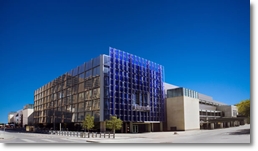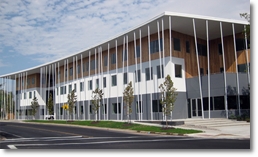Once the hippie sister of the construction industry, green building is getting itself all polished up and joining the mainstream.
 In Austin two very different projects illustrate the spread of green building principals here.
In Austin two very different projects illustrate the spread of green building principals here.
The Austin Convention Center retrofitted 370,967 square feet using green ideas while LifeWorks recently debuted a new 31,000 square foot resource center with environmental and educational goals.
As a result, The Convention Center has won the Gold LEED award from the U.S. Green Building Council. Lifeworks anticipates an Austin Energy Green Building certificate. Decision makers for both facilities chose to invest in green options. Despite the growth of green building, sustainable practices still cost more than traditional building. Consumers, businesses and governments grapple with understanding and justifying the return on investing in green building practices.
It’s one thing for a homeowner to choose to replace light bulbs with more expensive high efficiency CFL or LED lights. A $15 investment can be tracked relatively easily on a monthly electric bill.
It’s an entirely different level of investment when changes are applied to a Convention Center covering six city blocks or a nonprofit organization building a center using donation dollars.
Here the Austin Convention Center and LifeWorks share the decision-making and value assessments they employed in going green.
Can a building send you to college?
Yes! The deliberate, thoughtful architecture of the new center and its graceful profile are inspirational for the community. LifeWorks serves 10,000 youth and families each year, providing support and services such as counseling, housing, education/workforce and youth development. Their programming helps youth transition from the most challenging of circumstances to self-sufficiency.
In March 2012, LifeWorks unveiled the Sooch Foundation Youth and Family Resource Center as part of a ground-breaking model to serve youth. The 31,000 square foot building, completed in 2011, expands LifeWorks’ service capacity by 25 percent.
Three primary considerations went into the development of the Resource Center: serving constituents, serving the community and meeting financial obligations as a nonprofit organization. LifeWorks’ architects, builders and staff worked with Austin Energy Green Building to make environmental sustainability a critical cornerstone.
Placing environmental standards at the core of these goals produced a building that is much more than a collection of high efficiency glass, heat-blocking overhangs and green materials. According to LifeWorks’ Executive Director, Susan McDowell, “The building design says to our clients, ‘You are going to college.’”
Reaping value from every decision
“It’s rare that a nonprofit gets to build this kind of building,” says McDowell. “Most of the time, nonprofits are interested in doing things as cheaply as possible. We involved our Capital Campaign donors from the very start about our emphasis on sustainability. Each and every one appreciated that we were very clear about it and forward thinking.”
McDowell says there was learning through each phase and decision of the build. Every decision weighed the costs against the value of a green choice versus the savings presented by a traditional choice. “Every single decision you make can have a big impact.”
McDowell acknowledges that they pursued a sustainable approach almost on “blind faith.” But they are closely tracking the operational efficiencies of the Resource Center and assessing the economic returns of its investments. The organization anticipates operational savings in utilities and materials. It intends to track utility costs, comparing it to other sites that it operates. The process also sparked attention to sustainability practices at all LifeWorks’ sites, offering the extension of energy cost savings.
But McDowell can already see the value of LifeWorks’ deliberative choice in serving their mission. “Clients come to LifeWorks and tell us ‘I feel like you have invested in me,’” says McDowell.
|
Can a building spark a new industry?
In 2007, the City of Austin mandated that all city buildings adhere to LEED (Leadership in Energy and Environmental Design) Silver or higher standards. The Austin Convention Center Convention Facilities Manager, David Thomas, took on the task of retrofitting 370,967 square feet of meeting space including five exhibit halls, seven ballrooms, and 54 meeting rooms. In October 2011, the Green Building Certification Institute Awarded the Austin Convention Center the LEED Gold Award, the highest recognition level
An array of initiatives has reduced the Convention Center’s carbon footprint by 97 percent since 2007. High efficiency fixtures light the entire building. All bathrooms employ high efficiency fixtures. Glueless carpet and sustainable paint products line the walls. Twelve-inch box HVAC filters process air more efficiently than standard 2-inch filters. Smart-irrigation systems and native plants reduce exterior water usage. See the full list of enhancements here.
Thomas estimates that the Convention Center’s $3 million investment in sustainability improvements will be recouped in five years. He already credits it with cutting 2009 and 2010 utility costs by 30 percent and reducing waste hauling by $60,000.
Sparking a shift
As the Convention Center continues monitoring the savings produced through sustainability investments, Thomas is particularly keen on the way the Convention Center’s sustainability practices are serving as a cultural and economic catalyst for Austin.
The crown jewel in the Convention Center’s sustainability efforts is the waste mitigation program. Five years ago, the Austin Convention Center diverted 30 percent of its million pounds of annual waste from landfills. Today, the Center has reduced its overall waste to 750,000 pounds, with 67 percent of that waste recycled, composted or repurposed.
That transition required a significant investment of manpower and a cultural shift by every individual in the Convention Center, including staff, conference organizers and attendees. Thomas credits the custodial staff with driving the waste mitigation project to success. According to Thomas, the custodial staff treats the waste reduction program “like it’s their own baby. It’s a nasty job and they love it.”
The Convention Center weighs all its trash, tracking the impact of each waste mitigation step. Over the past five years, Thomas has installed grids on compactors to limit certain types of trash, trained conference organizers, educated conference attendees, and created a process to manually sort every piece of trash processed through the Convention Center.
The City of Austin processes Convention Center recycling. Foam boards and other convention materials are often repurposed by the Austin Independent School District. Texas Disposal System turns 200,000 to 250,000 lbs of waste each year into compost material.
Today, Thomas calculates the return on the waste reduction programs by its impact on the Convention Center’s carbon footprint, financial savings in waste hauling and promotional benefits in attracting green events. Thomas’s hope is in the near future, the Convention Center’s trash will produce a positive revenue stream.
“The Convention Center produces such a volume of material that it can ultimately be an attractive draw for companies to make businesses out of these materials,” says Thomas.










